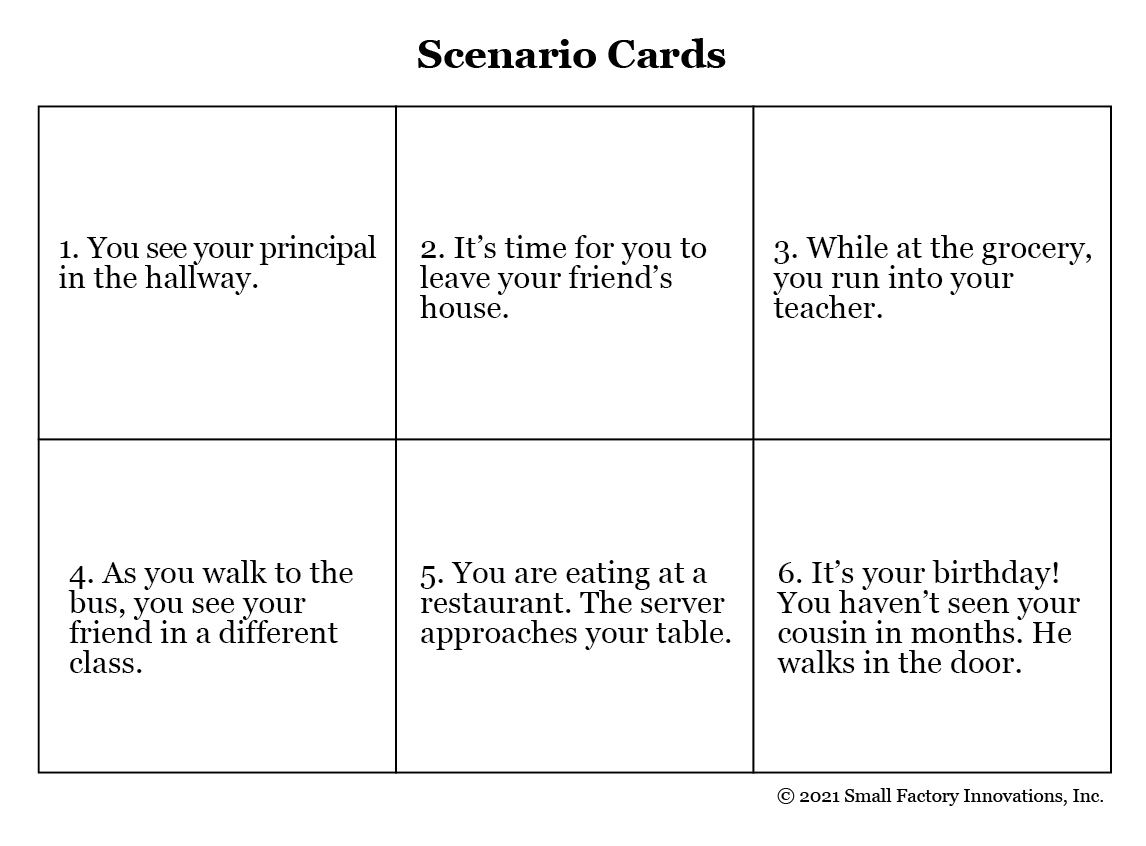
Improve life outcomes
Jumpstart: Greetings and Goodbyes - Universal
Jumpstart Universal SEL
CASEL Competency Focus: Responsible Decision Making
Time: 20-30 minutes
Materials: Example Greetings and Goodbyes (included), Music (Included), Scenario Cards (Included)
Objectives:
1. Initiate a greeting using words or phrases such as: hello, goodbye, have a nice day, (etc.).
2. Respond to a greeting directed at the student.
3. Distinguish between formal and informal greetings.
Definitions of Key Terms:
- Greeting: A polite word or signal to recognize others
- Informal Greeting: A word or phrase used to say hello in casual situations (mall, grocery, park, school, etc.) to friend, family members or any person with whom you have a friendly relationship
- Formal Greeting: A word or phrase used to say hello to a person in charge of you; or is an adult deserving of respect (teacher, principal, doctor, etc.)
- Acknowledge: Recognizing a person through talk or action upon seeing someone; especially someone you know.
Lesson Procedures
Introduction: They say, “You never get a second chance to make a first impression.” That is why it is important for students to learn and practice both appropriate greetings and goodbyes. There are several opportunities throughout the day to reinforce this skill with students. This skill can be naturally incorporated into morning and afternoon meetings. For older students, passing periods or at the beginning/end of each class is a great time to practice as well! This lesson addresses both informal and formal greetings and goodbyes, as well as the specific audience for the type of greeting. Share with students that the greetings are different in two ways; the choice of words and the people being addressed. Informal greetings are for family, friends and peers. Explain formal greetings and goodbyes in the same manner changing the audience and words/phrases. Example greetings and goodbyes are listed below.
Game Time: Musical Greetings and Goodbyes!
Discuss the importance of greeting people you see each day both in school and in the community. It is just as important to leave the conversation using common, appropriate words and phrases. Explain it is courteous and kind to recognize/acknowledge a person, especially those you know, when you see them.
Prior to playing, brainstorm a list of possible greetings and goodbyes with students appropriate for informal greetings (example informal and formal greetings and goodbyes are included). In this game, students will practice informal and formal greetings and goodbyes with peers. First, find an open space in the classroom or move desks if necessary. Instruct students to form two circles; to do this, have half the class form the first circle. Next, ask the remaining students to find a classmate and stand facing them, forming the inner circle. It’s now time for the game to start. Explain that when the music starts the outside circle will rotate around the circle until the music stops. Once the music stops, call out to students whether they will be giving a formal or informal greeting or goodbye to the person now across from them.. Continue the game by starting the music, but this time the inner circle will rotate during the music. When the music stops, repeat the steps above. For secondary students, consider providing them with a specific person they are to greet or saying goodbye to. For example, when the music stops, tell students they are to practice greeting their principal. Repeat the process as long as you would like. Click here if you would like to use the Jeopardy theme song during the game.
Application:
Use the scenario cards below to practice formal and informal greetings. In large or small groups read the scenario cards to students. Ask for volunteers to provide responses. Consider having secondary students create their own scenarios for classmates.
Try it out!
Encourage students to be intentional when greeting or saying goodbye. Have them try out using these greetings over the next few days and report back about their unique scenario.

